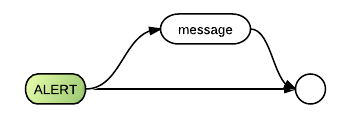Alert: Difference between revisions
(Imported ALERT command page from old wiki) |
(→Syntax) |
||
| (2 intermediate revisions by 2 users not shown) | |||
| Line 1: | Line 1: | ||
The '''Alert (AL)''' | The '''Alert (AL)''' command stops execution within a [[procedure file]] so that the operator may attend to the printer, change disks, or perform some other action. | ||
==Comments and Examples== | ==Comments and Examples== | ||
If you wish to tell the operator what to do while the program is suspended, you may include a message with the ALERT command. | If you wish to tell the operator what to do while the program is suspended, you may include a message with the ALERT command. | ||
| Line 13: | Line 14: | ||
==Syntax== | ==Syntax== | ||
[[Image: | Alert [<message>] | ||
[[Image:Alert.png]] | |||
==Defaults== | |||
Stop execution without sending a message. | Stop execution without sending a message. | ||
==Parameters== | ==Parameters== | ||
The ALERT command takes only one parameter, '''message''', which is separated from the command by a space. | |||
The ALERT command takes only one optional parameter, '''message''', which is separated from the command by a space. | |||
==Technical Considerations== | ==Technical Considerations== | ||
# If an ALERT command is encountered when PROC NOECHO is in effect, the operator must press F2 or F3 to view the message in the ALERT command. Use of PROC ECHO before and PROC NOECHO after the ALERT command is recommended to avoid this situation. | # If an ALERT command is encountered when PROC NOECHO is in effect, the operator must press F2 or F3 to view the message in the ALERT command. Use of PROC ECHO before and PROC NOECHO after the ALERT command is recommended to avoid this situation. | ||
# ALERT will display a message even if PROC NOECHO is active. | # ALERT will display a message even if PROC NOECHO is active. | ||
Latest revision as of 00:19, 6 May 2014
The Alert (AL) command stops execution within a procedure file so that the operator may attend to the printer, change disks, or perform some other action.
Comments and Examples
If you wish to tell the operator what to do while the program is suspended, you may include a message with the ALERT command.
BR suspends execution of a procedure file when it reaches the ALERT command. The computer beeps and the word ALERT, along with the specified message (as in the following example), appears on the 23rd line:
ALERT Insert PAYROLL backup tape.
You may enter other system commands (STATUS ALL, for example), while the ALERT status is active. Entering the GO command resumes execution of the procedure file. CLEAR ALL and CLEAR PROC allow you to exit the procedure file when the ALERT command is active.
CLEAR PROC followed by a PROC command allows you to exit the current procedure and begin executing another.
Syntax
Alert [<message>]
Defaults
Stop execution without sending a message.
Parameters
The ALERT command takes only one optional parameter, message, which is separated from the command by a space.
Technical Considerations
- If an ALERT command is encountered when PROC NOECHO is in effect, the operator must press F2 or F3 to view the message in the ALERT command. Use of PROC ECHO before and PROC NOECHO after the ALERT command is recommended to avoid this situation.
- ALERT will display a message even if PROC NOECHO is active.
